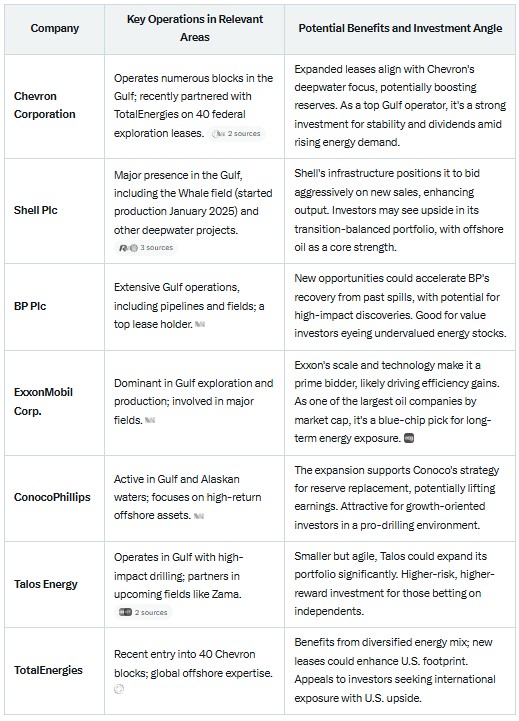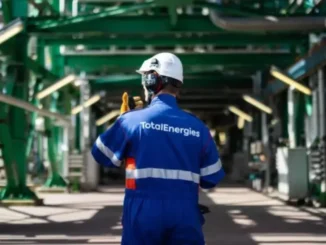
In a bold move to revitalize American energy production, the Trump administration has unveiled a sweeping offshore oil and gas leasing schedule through the Department of the Interior (DOI). Announced on August 19, 2025, this initiative marks a stark reversal from the restrictive policies of the previous Biden administration, aiming to unleash domestic resources and reduce reliance on foreign energy imports. The plan, aligned with the One Big Beautiful Bill Act (OBBBA), promises over 30 lease sales in key offshore regions, potentially injecting billions into the economy while creating thousands of jobs. But what exactly does this expansion entail, where will the drilling occur, and which companies stand to gain the most? Let’s dive in.The DOI’s Announcement: A Roadmap to Energy DominanceThe DOI’s press release outlines a long-term offshore leasing schedule designed to “deliver on President Trump’s promise to expand American energy production.”
This comes on the heels of Trump’s first-day executive actions in January 2025, including declaring a national energy emergency and resuming quarterly onshore lease sales. The offshore focus is particularly ambitious, with the Bureau of Ocean Energy Management (BOEM) tasked with holding at least 30 auctions for oil drilling rights in U.S. oceans over the next 15 years.
By 2028, ten sales are planned, ramping up to semi-annual events thereafter.This expansion contrasts sharply with the Biden era, which featured a record-low leasing schedule, a last-minute drilling ban across millions of acres, and a pivot toward green energy like offshore wind.
Interior Secretary Doug Burgum emphasized that the OBBBA represents a “landmark step toward unleashing America’s energy potential,” fostering job growth and energy security.
The Gulf region alone accounted for 14.5% of U.S. oil production in 2022, underscoring its strategic importance.The schedule provides “much-needed clarity and stability” for the industry, encouraging investments in deepwater infrastructure and bolstering national energy resilience.
Economic benefits could be substantial, with past lease sales generating millions in revenue and supporting local economies through increased state payouts from Gulf energy leases.
Where the Drilling Locations Are Opening Up
The expansion targets two primary areas: the Gulf of America (formerly known as the Gulf of Mexico in some contexts) and Alaska’s Cook Inlet. These regions are rich in untapped reserves and have been hotspots for offshore activity.
Gulf of America: This will be the epicenter of the expansion, with at least 30 lease sales scheduled from December 2025 through March 2040. Sales will occur twice a year in March and August, starting with “Big Beautiful Gulf 1” on December 10, 2025.
The Gulf remains the nation’s primary offshore source of oil and gas, producing about 97% of all U.S. Outer Continental Shelf (OCS) output.
New leases will include all available unleased areas in federal waters, potentially opening millions of acres for exploration.
Fields like Whale, which came online in January 2025, highlight the region’s ongoing productivity.
Alaska’s Cook Inlet: Six lease sales are planned through 2032, with the first set for March 2026.
This area offers opportunities for new jobs and economic growth in Alaska, though it’s less developed than the Gulf. Companies like Hilcorp have shown interest in Alaskan bids, signaling potential for expanded operations.
These locations were chosen for their proven reserves and infrastructure, with the Gulf’s pipelines and fields already supporting major operations. The plan also includes provisions for additional sales under a new five-year OCS program, which could replace the existing 2024-2029 framework.
Who Are the Players? Companies Poised to Benefit and Investment Potential
The expansion is a boon for oil and gas firms with expertise in offshore drilling, particularly those already active in the Gulf. While the DOI announcements don’t name specific bidders, industry analysts point to major players likely to participate in upcoming auctions. These companies could see increased production, revenue growth, and stock appreciation as leases translate into new reserves. Here’s a look at key players and why they stand to gain:
Other notables include Harbour Energy, Occidental Petroleum, and even PEMEX for cross-border plays, though U.S. firms dominate.
Hilcorp may eye Cook Inlet expansions.
With $54 billion in engineering and construction opportunities projected for offshore oil and gas in 2025, these companies are well-positioned to capitalize.
However, critics note the oil market’s saturation, suggesting benefits may accrue more to CEOs than consumers.
Looking Ahead: Opportunities and Challenges
This lease expansion signals a return to “American Energy Dominance,” but it faces hurdles like environmental reviews and market dynamics. For investors, focusing on established Gulf operators could yield solid returns, especially if global demand surges. As the first sale approaches in December, keep an eye on bid announcements—these will reveal the true players in this high-stakes energy game. We will be watching to see how these lease purchases play out, and how they impact their next earnings reports.
Stay tuned to Energy News Beat for updates on this developing story.
Avoid Paying Taxes in 2025
Crude Oil, LNG, Jet Fuel price quote
ENB Top News
ENB
Energy Dashboard
ENB Podcast
ENB Substack





